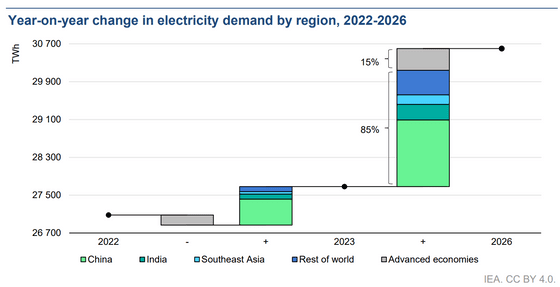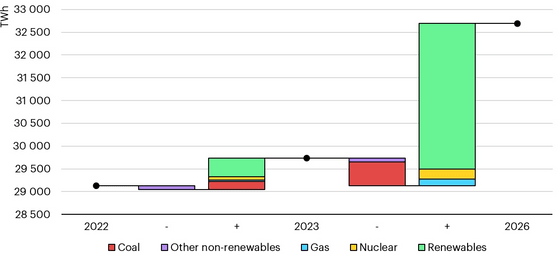It is predicted that the electricity consumed by the world's data centers will rival that of Japan by 2026, and the International Energy Agency predicts that 'clean' electricity such as nuclear power will cover the doubling of energy demand due to AI and virtual currency.

On January 24, 2024, the International Energy Agency (IEA) released a report stating that the power consumption of data centers will double by 2026 due to the rapid development of technologies such as AI and virtual currency. The IEA also forecasts that clean energy, such as renewables and nuclear power, will outpace growth in electricity demand.
Electricity 2024 – Analysis - IEA
Clean sources of generation are set to cover all of the world's additional electricity demand over the next three years - News - IEA
https://www.iea.org/news/clean-sources-of-generation-are-set-to-cover-all-of-the-world-s-additional-electricity-demand-over-the-next- three-years
According to the IEA's annual report ' Electricity 2024 ,' the increase in global electricity demand in 2023 was limited to 2.2% due to a decline in electricity consumption in developed countries. However, due to the strong growth of emerging economies, electricity demand is expected to increase at an average annual pace of 3.4% for the three years starting in 2024.
The following is a graph showing forecasts for changes in electricity demand from 2022 to 2026 by region, with yellow-green showing China, green showing India, light blue showing Southeast Asia, gray showing developed countries, and blue showing other regions. .

As China's economic growth slows and its dependence on heavy industry declines, the pace of growth in electricity demand in China is expected to slow, but it will still reach 1,400 terawatt hours (TWh) by 2026. It is thought that this will amount to about half of the EU's annual consumption.
From this point of view, the IEA says, ``About 85% of additional electricity demand by 2026 is expected to come from countries other than developed countries, and China in particular will make a significant contribution to demand growth, even as it undergoes structural changes.'' That's what I mean.
Focusing on power consumption by industry, the areas where power consumption is increasing most significantly are virtual currency and AI, which will double the energy consumed by data centers around the world from 460TWh in 2022 to 1000TWh in 2026. It is estimated that this will be equivalent to the power consumption of the entire country of Japan.
Therefore, the IEA stated that 'updated regulations and technological improvements such as efficiency are essential to mitigate the rapid increase in energy consumption by data centers.'

As the amount of electricity required by human society increases, low-emission energies such as renewable energies such as solar, wind, and hydropower, as well as nuclear power generation, are promising technologies to meet future energy demands.
In particular, renewable energy is expected to account for more than one-third of total power generation by early 2025, overtaking coal. In addition, starting with
The following is a graph of changes in global power generation from 2022 to 2026. While coal (red), the representative fossil fuel, and other non-renewable energy (purple) are expected to decrease, gas (light blue), nuclear power (yellow), and renewable energy (green) are expected to increase significantly. is expected.

Although gas-fired power generation will increase due to the switch from coal to gas, overall fossil fuel power generation is expected to decline at an unprecedented rate, accounting for the largest share of power generation in the past 50 years since the IEA started keeping records. This is the first time that a prediction has been made that the proportion of fossil fuels will fall below 60%.
IEA Director-General Fatih Birol said, ``Currently, the electricity sector emits the most carbon dioxide in the world economy, so the rapid growth of renewable energy and steady expansion of nuclear power generation will lead to It is encouraging to see that the growth rate is matching the annual increase in global electricity demand.'
Related Posts:
in Note, Posted by log1l_ks







